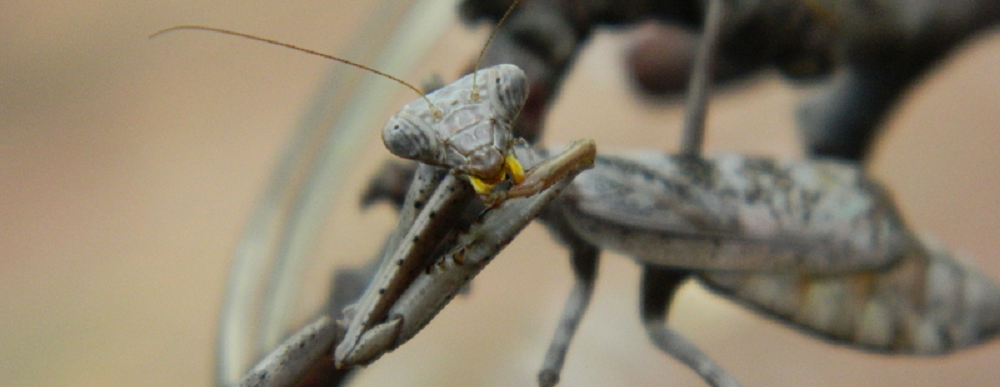Carolina Mantis Caresheet
Housing
The Carolina mantis (Stagmomantis carolina) should be kept in an enclosure that is at least 3 times as tall as the mantis is long, and at least 2 times as wide as the mantis is long. The enclosure must also have adequate ventilation, and some kind of material on the ceiling of the enclosure which will allow the mantis to hang upside down during molting, as well as an empty space at the top which is at least 2 times the size of the mantis. They can be kept in glass or mesh cages, but enclosures with glass or clear plastic sides and a mesh or screen top are ideal, due to the humidity requirements of this species. The size of this mantis differs between the sexes, but sexing Carolina mantises as adults is easy, because the sexes look very different as well! Adult males are about 1.7 inches long, and have long wings and a long body. They are brown with green legs. For females, they can grow up to 2.5 inches long, but are usually closer to 2 inches long as adults. She has short wings that don’t even reach the bottom of her abdomen, and she is big and bulky in the middle. Colors range from very green to brown and grayish.
Carolina mantises can be kept successfully in a living vivarium with live plants and microfauna (e.g., springtails and isopods) who will act as a sort of "clean up crew" by breaking down the mantis's waste. They can also be kept in a temporary enclosure such as a mesh cage or screen cage, with silk plants (such as an Ivy Branch, Leafy Branch, Orchid Flower, or White Flower) and an easily disposable substrate such as sphagnum moss, or even just a paper towel that you can change once a week. They are generally a hardy species and very low maintenance to care for, so they will be happy in any enclosure really, as long as it is big enough for them. PanTerra’s Box can be used to comfortably house this species for most of their lives, but should be moved to something bigger right before their final molt, and to live out the rest of their adult lives.

Temperature & Humidity
Carolina mantises are native to the southeastern United States, but are commonly found throughout most of the United States, especially in people’s gardens! Because of this, they can tolerate a wide range of temperature and humidity, due to the seasonal fluctuations of the southeastern United States. In captivity however, the ideal temperature for a Carolina mantis is between 70°F and 85°F. Humidity should be kept between 60% and 80% relative humidity (RH).
Depending on the amount of ventilation, the enclosure should be given a light misting once a day. Carolina mantises kept in mesh or screen cages should have their enclosures misted twice a day to maintain proper humidity. Not only that, but misting the enclosure also allows the mantis to drink. Most mantises do not like getting sprayed directly, so it is best to try and spray around the mantis, but if you get them a little wet by accident, it is usually no big deal. Use spring water, distilled water, or water filtered by reverse osmosis (RO), but do not use plain tap water.
Feeding
Carolina mantises will eat a wide range of insects, but when kept in captivity, we recommend using flying insects throughout their entire lifecycle.
- L1 – L2 nymphs: Should be fed D. melanogaster fruit flies.
- L3 – L4 nymphs: Should be fed D. hydei fruit flies.
- L5 nymph to adult: Should be fed house flies or blue bottle flies.
These mantises do not have a problem actively pursuing prey insects, as long as they are in close enough range to chase down.
For additional information about the Carolina mantis, including breeding and ootheca care please reference the links below:
Carolina Mantis (Stagmomantis carolina) Caresheet – Keeping Insects
